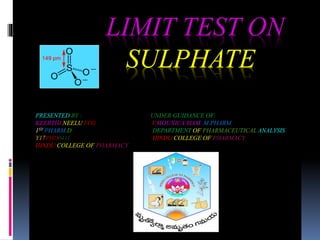
Limit test on sulphate
- 1. LIMIT TEST ON SULPHATE PRESENTED BY : UNDER GUIDANCE OF: KEERTHI.NEELU FOR V.MOUNICA MAM M.PHARM 1ST PHARM.D DEPARTMENT OF PHARMACEUTICAL ANALYSIS Y17PHD0411 HINDU COLLEGE OF PHARMACY HINDU COLLEGE OF PHARMACY
- 2. Contents : Definition of Limit test Types of factors accomplished Types of factors accomplished by Control of Personal Errors Apparatus required for limit test on sulphate Chemicals required Preparation and Procedure Observations and Result’s References
- 3. LIMIT TEST : They are quantitative or semi quantitative tests designed to identify & control small quantities of impurity which are likely to be present The design of individual tests is therefore important if errors are to be avoided in hands oh different operators These are accomplished by giving attention to a number of factors. They are 1.Specificity of tests 2.Sensitivity 3.Control of personal errors
- 4. 1.Specificity of tests :Any test used as limit test must necessarily give some form of selective reaction with trace impurity. A test may be demanded which will exclude one specific impurity ,but highly specific tests are not always the best; a less specific test which limits several likely impurities at once is obviously advantageous & it can be accomplished For Example : Heavy metals test is applied to alum which not only limits contamination by lead , but also other heavy metal contaminants precipitated by thioacetamide as sulphide at pH 3.5. 2.Sensitivity :Degree of sensitivity required in limit test varies enormously according to standard of purity demanded by monograph. Sensitivity of most tests is dependent upon a number of variable factors all capable of strict definition , and all favourable towards production of reproducible results. Thus precipitation of an insoluble substance from solution is governed by such factors Concentration of solute & of precipitating reagent Duration of reaction Reaction temperature Nature & concentration of other substances unavoidably present in solution
- 5. 3.Control of Personal Errors : It is essential to exclude all possible sources of ambiguity in description of a test . Vague terms such as “ Slight precipitate” should be avoided as far as possible . Extent of visible reaction to be expected under specified test conditions should be clearly and precisely defined . This is usually accomplished in one of three ways A. Tests in which there is no Visible reaction B. Comprison methods C. Quantitative determinations
- 6. 1.Tests in which there is no visible reaction : A definite statement is incorporated in wording of test , which states that there shall be no colour , opalescence or precipitate , whichever is appropriate to particular test . For Example : This type of requirement is test for barium and calcium in Dilute Hypophosphorus . Acid ( BP Appendix 1) where additions of dilute sulphuric acid under precisely controlled condition shall produce ‘ no turbidity , or precipitate ’within 1 hour . The time factor is used here means of increasing sensitivity of test . Tests which give negative results don’t necessarily imply complete absence of impurity .
- 7. 2.Comprison methods : Test of this type require a standard containing a definite amount of impurity , to be set up at same time & under same conditions as test experiment. In this way extent of reaction is readily determined by direct comparison of test solution with a standard of known concentration. Official limit tests for chlorides , sulphate , iron , heavy metals are based on principle.
- 8. 3.Quantitative determinations : Quantitative determination of impurities is only applied in special circumstances , usually in those cases where limit is not readily suspectible to simple & more direct chemical determination . This method is used in following different types of test : I. Limits of insoluble matter II. Limits of soluble matter III. Limts of moisture , volatile matter , and residual solvents IV. Limits of non-volatile matter V. Limits of residue on ignition VI. Loss on ignition VII. Ash values VIII.Precipitation methods
- 10. APPARATUS : Nessler’s cylinder , Glass rod
- 11. Measuring cylinder , Pipette
- 12. Dropper , Rubber stopper
- 13. Chemicals required : Barium sulphate reagent 0.05 M Barium chloride solution is prepared by dissolving 12 gm of barium chloride in 1000 ml of water, to the 15 ml of the above solution add 55 ml of water , 20 ml of alcohol and 5 ml of 0.0181% w/v solution of potassium sulphate and the final volume was made up to 100 ml
- 15. Preparation of ethanolic standard solution ( 10 PPM ) ) Dilute 1 volume 0.1089% w/v solution of potassium sulphate in Ethanol (30%) to 100 volumes with ethanol (30%)
- 16. Preparation of sulphate standard solution (10PPM ) Dilute 1 volume of a 0.1089% w/v solution of potassium Sulphate in distilled water to 100 volumes with distilled water
- 17. Procedure:
- 19. Observation : The turbidity produced in the test solution is lesser than standard solution Inference : Given substance passes limit test for sulphate as per Indian Pharmacopeia when compared with that of a standard substance . FOR SAMPLE – 1 PASSED SAMPLE
- 20. FOR SAMPLE – 2 FAILED SAMPLE Inference : The given substance fails the limit test for sulphate as per Indian Pharmacopeia when compared with that of a standard substance . Observation :The turbidity Produced in the test solution Is more than standard solution
- 22. THANK YOU